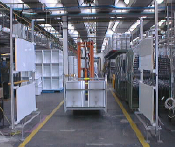Aug. 7, 2003 – Whirlpool Europe has outfitted a refrigerator and freezer factory in Trento, Italy, with RFID readers from Lab ID, a systems integrator based in Bologna, to track components from a warehouse to the production line.
The system will provide real-time information about what components are in stock, reduce manual work and cut costs by reducing errors.
The Whirlpool production facility is 788,600 square feet (73,300 square meters), has 820 employees and produces 1 million refrigerators each year. Some 15,000 metal cargo units have been outfitted with 13.56 MHz RFID tags, which are compliant with the ISO15693 standard. Suppliers place components in a cargo unit and write the contents of the unit to the RFID tag. When the units are delivered, Whirlpool can scan the tags and automatically receive the goods into inventory. The cargo units are tracked as they move to the component warehouse and then to the production facility.
Whirlpool had been tracking the movement of components with bar codes on the cargo units. But that required personnel to manually scan the bar codes each time components were moved. If someone forgot to scan a bar code, the information in the system would be wrong. The RFID system not only reduces human labor, but also human error.
The Lab ID’s EH antennas have been set up at 10-foot-wide (three-meter) gates between the warehouse and production areas of the facilities. The antennas, which connect to a stantionary reader, are tall but thin, so they do not interfere with the operation of the lift track.
“We started this project in September 2002 and finished about two months ago,” says Marco Astorri, executive VP at Lab ID. “It shows that we can read from and write to the tag from a distance of more than one meter, even on a metal cargo unit.”
When components are placed in a cargo unit, the information is recorded in the warehouse management system. Then, as the cargo unit is moved, the antennas automatically read the tag on the cargo unit and update the location information in the database.
“RFID gives us a chance to achieve real-time material stock,” says Fulvio Zaffaroni, a senior engineer for Whirlpool. “It lets us track what the supplier has in inventory, reduces labor at the receiving dock, and reduces material handling and line feeding activity.”
The current system is deployed at two gates leading to the primary process facility. That could be expanded to other areas, and Whirlpool may use handheld readers to track cargo units. The facility currently has 25 different types of cargo units, and the gates are designed for specific types of units. Whirlpool plans to use standardized cargo units so they can be tracked with RFID at all gates.
If the system proves successful, it could be rolled out to other facilities in Europe. “It’s early to plan RFID activities in other Whirlpool Europe component warehouses,” says Zaffaroni. “We must gather more information on the results [of the RFID implementation] at this site.”


